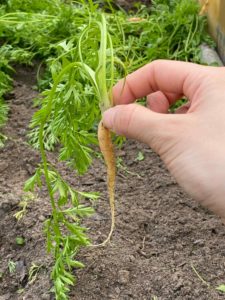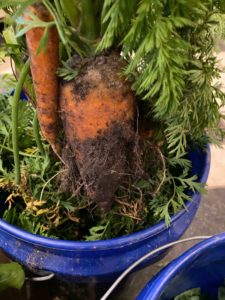Domesticated carrots are a popular root vegetable and a staple in many gardens. Carrot roots and leaves have been used medicinally for thousands of years and the most common cultivars are descendants of Iran and Persia. Carrots slowly spread through the West, making their way through Spain and into Northern Europe. By about the 1500s, the orange and yellow carrots we know today became widespread.
 Carrots are versatile and can be prepared in numerous ways. They can be chopped or grated to be included in salads, or sauteed, boiled, steamed, and roasted when preparing to be served as a side dish. Baby carrots are a small and sweet tasting variety that are frequently eaten raw with dips. Carrots are high in vitamin A and beta-carotene. They can also be a great source of vitamin C, K, and fiber.
Carrots are versatile and can be prepared in numerous ways. They can be chopped or grated to be included in salads, or sauteed, boiled, steamed, and roasted when preparing to be served as a side dish. Baby carrots are a small and sweet tasting variety that are frequently eaten raw with dips. Carrots are high in vitamin A and beta-carotene. They can also be a great source of vitamin C, K, and fiber.
The four most common types of carrots are: Chantenay, Nantes, Danvers, and Imperator. Chantenay carrots tend to be short and thick with rounded ends. They typically grow to 5 inches in length and 2 inches thick. Nantes and Danvers usually 7 inches in length and only 1 inch thick. They also have a sweeter flavor. Lastly, Imperator carrots are the largest variety, usually with a length of 8 inches and 2 inches thick. You can sometimes find Imperator carrots in purple, yellow, and even white!
How to Plant Carrots
Carrots are annuals that grow best in growing zones 3-10. They require full sun and a neutral to slightly acidic soil 6.0 – 7.0 pH. Ideal soil is loamy, although small carrot varieties can grow in thicker soils. If starting from seed, sow directly into the garden by digging a quarter inch deep and spreading the seeds an inch apart. As they begin to sprout, thin the seeds to be 3-4 inches apart. Carrot rows should be 18-24 inches apart. If planting in containers, utilize large containers to ensure the carrots have enough room to grow. Containers should be at least 10-12 inches across and deep. If you live in a warm climate, containers enable you to bring them inside on scorching hot days. Carrots prefer cooler weather. Too much heat can cause the carrots to become firm and bitter. Also, applying a 10-20-10 npk fertilizer will do wonders for your carrots as they grow in the garden.

Harvesting Carrots
Depending on the variety of carrot, carrots take 50-75 days to reach maturity. Since the entire carrot growth takes place below the soil, we recommend consulting with the recommendations on your carrot seed packet on when to pull them from the ground. Carrots pulled too early will be bland and lack the sweeter flavors carrots typically have. Gently loosen the soil around the carrot, then slowly twist back and forth while pulling up until they are removed. Before storing your carrots, slice 1 inch off the top and thoroughly remove all dirt on the carrots then refrigerate.
Carrot Pests and Diseases
Aster Yellow Disease is a bacterial infection that will cause discoloration on the tops of the carrots and cause them to have a bitter taste. This disease is spread by insects that feed on small plants. To minimize the risk of this infection, make sure your carrot garden is thoroughly weeded.
 Black Canker is a type of fungus that caused canker blisters on the crowns of the carrots. These cankers will be brown, purple, or black and eventually cause the carrot flowers to rot. Choose disease resistant varieties to minimize risk to black canker.
Black Canker is a type of fungus that caused canker blisters on the crowns of the carrots. These cankers will be brown, purple, or black and eventually cause the carrot flowers to rot. Choose disease resistant varieties to minimize risk to black canker.
Carrot Rust Flies are small insects that burrow into the carrots and leave tunnels with a rust color excrement in the roots and tops. These flies cause the carrots to wilt and eventually rot. Hanging yellow sticky traps in your garden to catch the flies or employing predatory insects by planting native flowers should help.
Flea Beetles can be managed by planting native flowers to invite predatory insects into your garden.
Root-Knot Nematodes will cause your carrots to appear “knotted,” stunted, wilted, and pimpled. To manage these nematodes, solarize your soil after destroying infect crop residue. Remove all infected plants, then apply black plastic over the soil to solarize it.

Contact Author
 info@gardensavvy.com
info@gardensavvy.com Recent Posts
- Smart Gardening: How Technology Is Revolutionizing Horticulture
- Understanding Gardening Zones: What You Need to Know
- The Right Tools For Your Gardening And Landscaping Needs
- Maximizing Your Harvest: Square Foot Gardening Chart for Beginners
- Holiday Garden Scents: Plants for Natural Aromatherapy in Your Home









